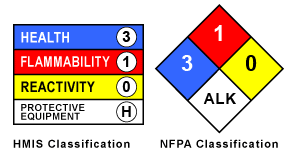What is it?
Anhydrous ammonia has a sharp odor and is both naturally occurring and commercially manufactured. The term “anhydrous” means “without water”.
How is it used?
Anhydrous ammonia is one of CALAMCO’s key fertilizer products. It is used as a direct application of nitrogen and as an ingredient in the manufacture of some specialty fertilizers. Anhydrous ammonia is also a refrigerant gas, in chemical manufacturing and numerous other industrial uses.
What are the potential hazards?
Anhydrous ammonia is transported as a liquid. In the event of a spill it can form a vapor cloud that may be heavier than air until its temperature increases.
Anhydrous ammonia is corrosive to copper, silver, aluminum, zinc and zinc alloys. It reacts with body moister and burns skin, eyes, mouth, throat, lungs and stomach tissues on contact if inhaled or swallowed.
Although the smell of ammonia is unpleasant and sharp it is generally tolerable up to 25 parts-per-million (ppm). Above this concentration irritation of the eyes, nose and throat may begin. 25ppm is also the OSHA permissible exposure limit. Above 400ppm skin burns and coughing occur.
The U.S. National Institute for Occupational Safety and Health (NIOSH) has established 300ppm as the concentration that is immediately dangerous to life and health (IDLH).
Is it flammable or explosive?
Anhydrous ammonia is considered a non-flammable gas; .at certain concentrations in enclosed spaces it can be made to explode.
What are the emergency response procedures?
In the event of a spill of anhydrous ammonia, local authorities will access the scene. Possible actions include, but are not limited to, evacuation of the area, or implementing Shelter-in-Place procedures (see section titled “if there has been a release of toxic vapors”). The emergency responders will attempt to stop the leak of anhydrous ammonia. Emergency responders should not mix water used for firefighting directly with anhydrous ammonia as this will result in warming of the product causing the liquid to turn into a vapor cloud. Water spray down wind of the leak source can absorb ammonia gas and diminish the vapor cloud.
What to do if you are exposed.
Eye Contact:
Check for and remove contact lenses. Immediately flush with running water for al least 30 minutes, keeping the eye lids open. Use warm water if available. Obtain immediate medical attention.
Skin Contact:
Remove contaminate clothing as quickly as possible. Flush exposed skin with large amounts of water for at least 30 minutes. Use warm water if possible. If irritation persists seek medical attention. Dispose of contaminated clothing in a manner that limits further exposure.
Minor Inhalation:
Using appropriate respiratory protection remove the affected individuals from the area of exposure. Allow the person to rest in a well ventilated area, if irritation persists obtain medical attention.
Severe Inhalation:
Using appropriate respiratory protection evacuate the affected individuals to a safe area as soon as possible. Loosen tight clothing around the person’s neck and waist. If breathing is difficult administer oxygen. If the person is not breathing perform artificial respiration and obtain medical attention.
Ingestion:
If the victim is not breathing, begin artificial respiration and continue until the victim is breathing. Do not induce vomiting. Call a physician or poison control center and seek immediate medical attention. If tolerated and the victim is conscious give water to rinse the mouth and throat and dilute the stomach contents.
What to do in the event of a spill.
What to do in the event of a release of vapor.
You may wish to:
Unless you are told by authorities:
When you have been advised of an ALL CLEAR by local authorities, open your house to air it out.
